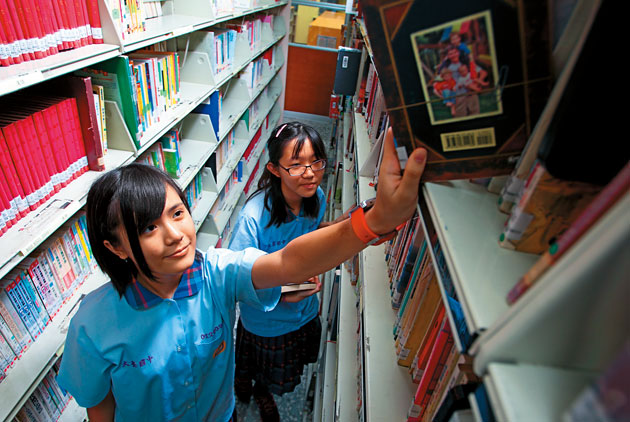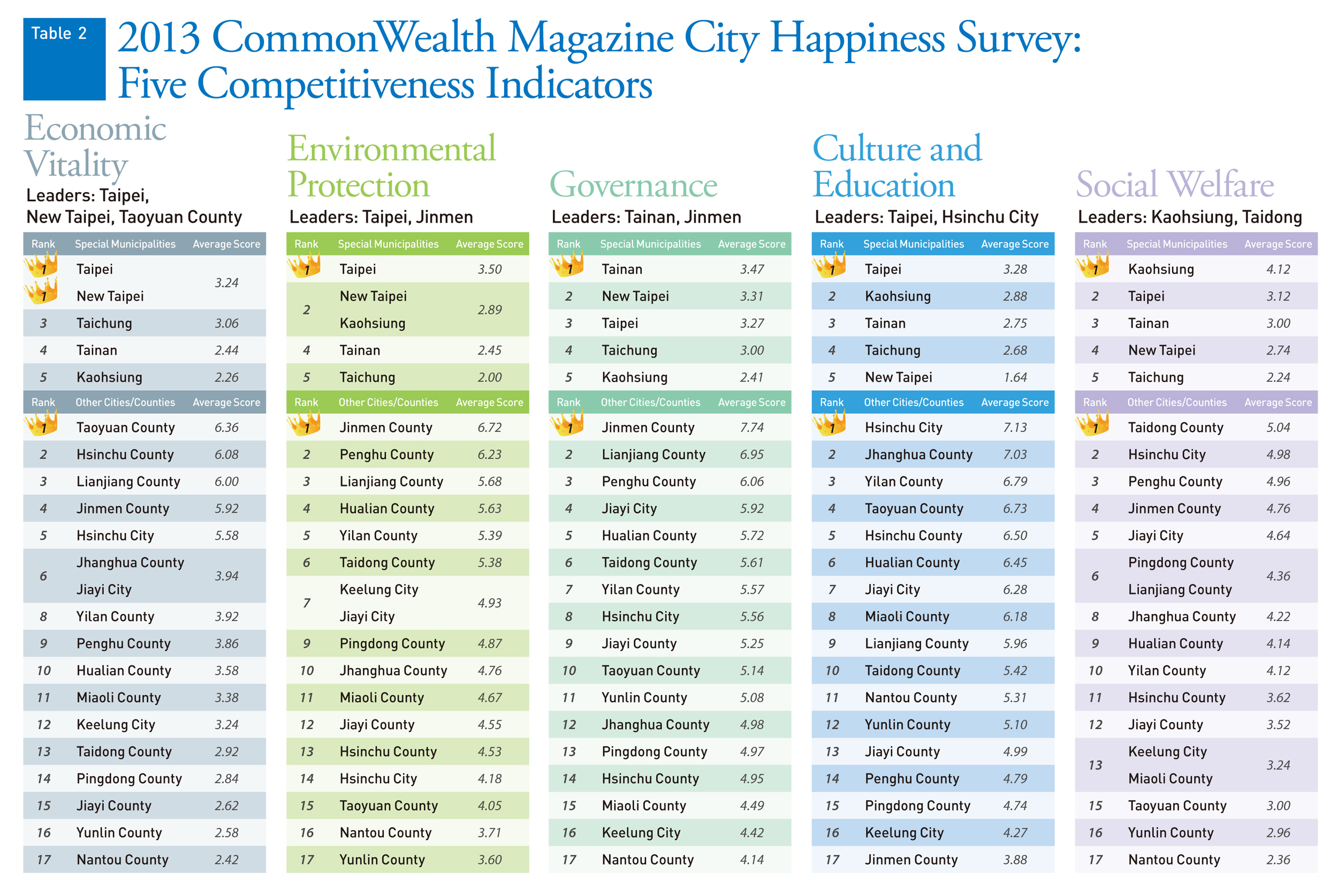2013 City Happiness Survey
Ramping Up Reading

Source:CW
With the bold ambition of becoming a "city of reading," Kaohsiung is pooling the resources of its 61 public libraries, making millions of books available to its schools. Throughout Taiwan, cities are raising competiveness by elevating culture, and the answer lies in books.
Views
Ramping Up Reading
By Uidy KaoFrom CommonWealth Magazine (vol. 531 )
It is late August shortly before the beginning of the new school year. The teachers of Da-Liao Junior High School in Kaohsiung are already back in school for professional training, including a special course on reading education.
Da-liao Junior High is almost fifty years old. Due to Taiwan's chronically low birthrate and the community's population loss, student numbers have dwindled from more than 3,000 students at the school's peak to some 1,300 students now. Most recently, school efforts have been focusing on reading education. Although the school has only a meager annual book procurement budget of NT$100,000, which buys about 300 books, its students have access to a broad selection of 3.8 million public library books. Behind the scheme are collective library cards that are issued to every class.
Kaohsiung was the first to introduce a "class library card" system, which pools the resources of the 61 municipal libraries within the city's 38 districts. Based on recommendations by the city government's Education Bureau, the libraries buy books and provide them to local elementary schools and junior high schools.
Free Citywide Express Delivery
Teachers can use the class library card to borrow sets of books that are on the respective grade's reading list. Books can be borrowed across districts and are delivered to the classroom by a commercial express delivery service. The delivery costs are shouldered in full by the municipal libraries.
Thanks to the school's reading campaign efforts, virtually every new student at Da-Liao Junior High also holds an individual library card for the nearby Daliao Branch of the Kaohsiung Municipal Library.
Da-Liao Junior High principal Tian Chia-li notes that the school library owns just 20,000 books. However, since the local library branch boasts more than 50,000 volumes, students effectively have access to more than 70,000 books. Through the class library card system, schools can draw on the resources of the entire municipal library system – a vast collection of 3.8 million books with a steady influx of new publications.
"This is a way of narrowing the urban-rural divide," declares Education Bureau Chief Secretary Tai Shu-fen. Due to the merger of Kaohsiung City with largely rural Kaohsiung County in late 2010, Greater Kaohsiung now covers an expansive area with vast disparities. Schools in remote, sparsely populated communities are allocated books for their school libraries, but most schools do not have dedicated library staff. As a result, the books sit in piles in corners collecting dust, because there is no one to catalogue them or to handle library services from book checkout to return.
In a bid to solve the lack of school resources in rural areas, the Kaohsiung Education Bureau cooperates with the Bureau of Cultural Affairs, which runs the municipal libraries, to pool library resources for joint use.
Since the class library card was introduced last year, more than 5,800 cards have been issued to the benefit of more than 200,000 students. Last year more than 120,000 books were checked out from public libraries through the scheme. The Education Bureau has also established a website for students which provides reading skills assessment.
Lin Chien-ru, a teacher at Da-Liao Junior High, used to take her students to the school library to make them read more. Yet the often outdated, worn out books – many of them textbooks – failed to stir any interest. Instead of reading, students took advantage of their library time to chat or nap. Now that the class library cards have been introduced, students can borrow the latest bestsellers such as The Life of Pi or popular martial arts novels such as Jin Yong's The Heaven Sword and Dragon Saber, unconsciously developing the habit of reading and improving their reading comprehension.
"Reading can change a person's destiny," believes Kaohsiung Mayor Chen Chu, who received an award for outstanding contributions to library culture from the Ministry of Education earlier this year. Chen can be loquacious in elaborating the details of her policy initiatives, which involve several departments. The city government does not want to see children in southern Taiwan fall behind their peers in northern Taiwan in terms of reading skills, she explains.
NT$2 Billion for a New Main Library
In order to create a reading-friendly environment in local communities, the Kaohsiung Education Bureau and Bureau of Cultural Affairs are jointly promoting the "Happy Neighborhood" project. Schools are required to establish community libraries on the first floor of their premises and open them to the public. Presently as many as 183 schools have opened their libraries to the public, including 51 elementary schools that are even open on weekends.
Moreover, the city government has called on enterprises to financially sponsor the purchase of seven dedicated bookmobiles. The first of its kind in all of Taiwan, this library fleet circulates books among the local libraries. Library users who order books online from another branch library are able to pick up the desired item at their local library within three days.
Since 2010, when Kaohsiung was expanded as a "special municipality," Chen has established at least one library per year. On top of the six libraries that have been built so far, seven more will be established in the coming two years.
Last October construction began for the city's new main library in the Asia New Bay Area near Kaohsiung Harbor. The NT$2 billion structure is expected to become a new landmark in the city.
Demonstrating its ambition to create a city of reading, the city government has also launched a book drive inviting corporations and the general public to donate a million books to the new library.
"Our book donation drive resembles a social movement," comments Chen. Public response has been overwhelming, with donations coming in from ordinary citizens and entrepreneurs, and even temples giving away a share of their own donations.
Tainan City: Reading Clubs on TV
But when it comes to promoting a good reading environment, Kaohsiung is not the only local government to take concrete action.
In recent years local governments have spared no effort to increase library book collections and improve library facilities. Some combine cloud technology with e-book resources, while others promote parent-child reading circles and storytelling events for small children to create an environment that encourages reading.
In the 2013 City Happiness Survey, comparing Taiwan's five large special municipalities and 17 second-tier cities and counties, Taipei still takes the lead in culture and education among the five metropolises. Taipei residents borrow an average of 4.75 books per capita from public libraries per year, while that figure stands at less than three in Taiwan's four other major cities.
Among the counties and smaller cities, Lianjiang County, Zhanghua County and Penghu County performed better than their peers. Not only does Taipei City boast a comparatively high book lending rate, but its municipal libraries also stock 2.5 books per city resident – much more than other cities can offer.
Taipei City government Spokesman Edward Chang remarks that the city has a dense network of branch libraries with exceptionally rich resources. The annual book procurement budget stands at around NT$80 million. In what Chang describes as a virtuous cycle, Taipei residents frequently use public library resources, imperceptibly reinforcing the habit of reading.
Pointing to previous cultural campaigns promoting etiquette in the Taipei mass transit system and encouraging drivers to yield to pedestrians, Chang asserts, "Taipei City also needs to create a culture of reading."
The city government has come up with a number of unconventional measures to make it even more convenient for residents to get their hands on books. In front of the main library's entrance, a FastBook fully automated lending machine with three shelves of books has been installed, where readers can check out and return books round the clock 365 days a year. Moreover, library shelves have been put up in 63 city buses serving three routes. Passengers can borrow books on the buses without a library card or any other form of registration and take them home. The system trusts that readers will listen to their conscience and return the borrowed books when boarding one of the library buses the next time.
Tainan City for its part uses a public television channel on the local cable TV network for broadcasting a reading club program. Every week prominent authors are invited to recommend good books. "Reading tours" to places across the greater Tainan area highlight local culture and various aspects of reading. The videotaped program can be viewed on demand on the Internet so that teachers can use it as supplementary teaching material.
Even remote places like the offshore island of Jinmen do their fair share to encourage reading. While teachers are trained as reading coaches, each school has also designated one teacher who is in charge of designing reading curricula. Since many children on Jinmen are brought up by their grandparents, the county's family education center promotes parent-child reading activities and parent-child joint learning camps for new residents.
Urban governance is attaching greater importance to cultural policy. Local chief executives have already discovered that the creation of a good reading environment is an important booster for community competitiveness.
Translated from the Chinese by Susanne Ganz







